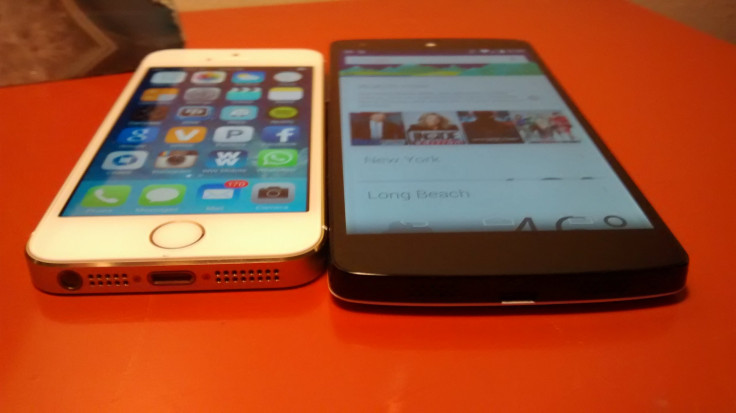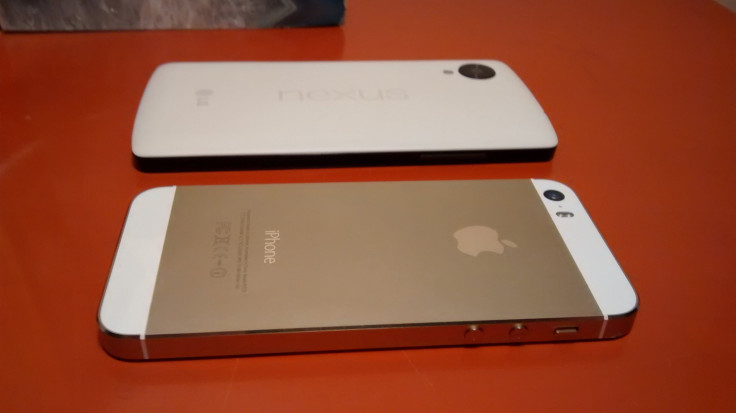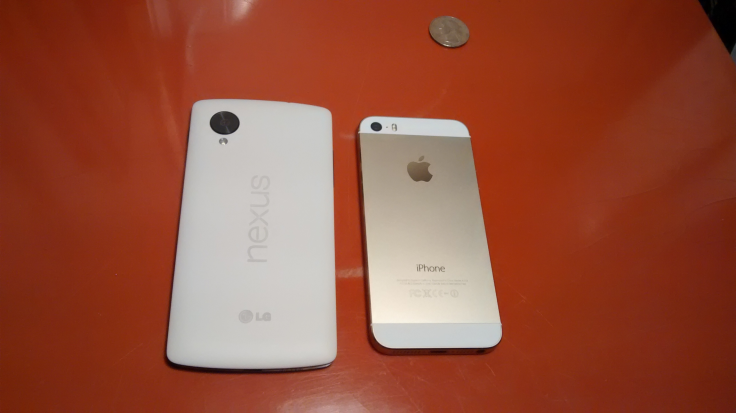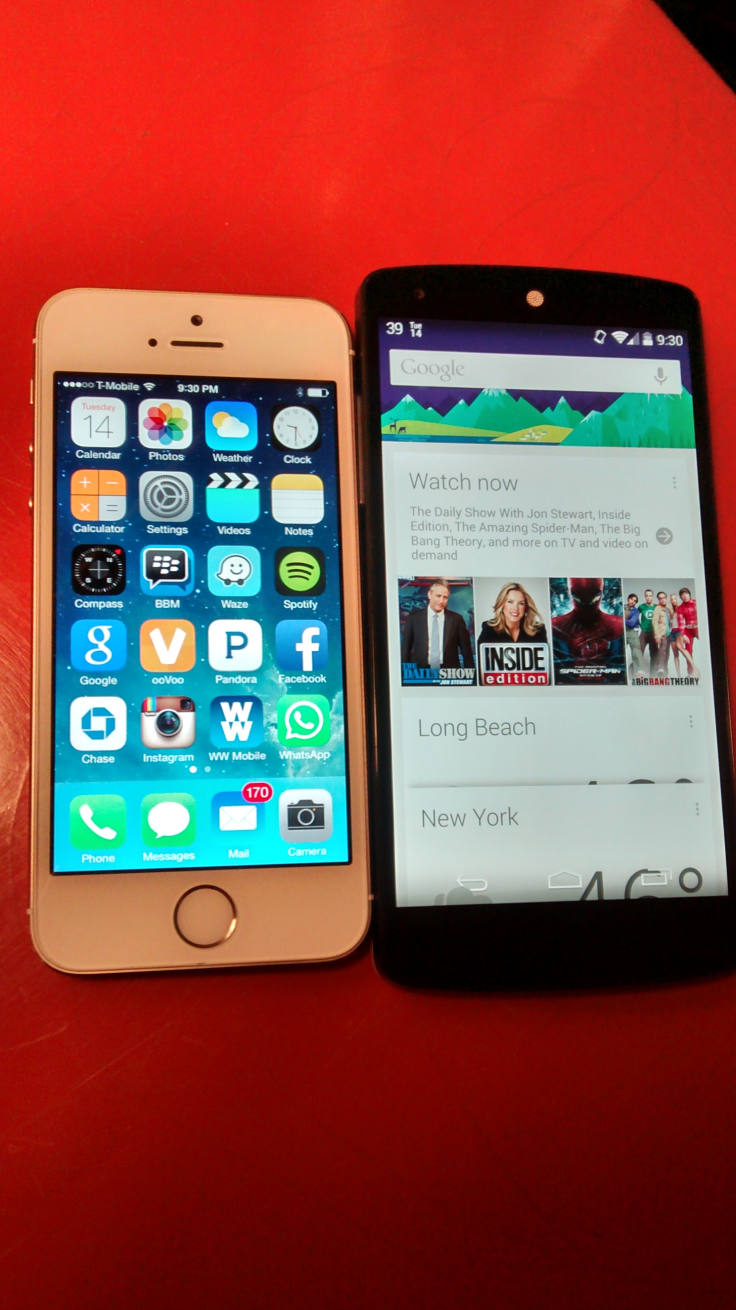Nexus 5 Vs. iPhone 5S In-Depth: How Google And LG’s Android Flagship Compares To Apple’s Latest In Benchmarks, Camera, Battery Life And Specs

Apple began selling the iPhone 5S in October 2013. Google followed the following month with the Nexus 5, manufactured by LG Electronics. Both smartphones are extremely popular, and will likely remain so for the rest of 2014.
Some iPhone and Android users take pride in their chosen platform, firmly believing that theirs is the better ecosystem. The competitive nature surrounding these devices likely has several causes, due in part to the fact that both Apple (NASDAQ:AAPL) and Google (NASDAQ:GOOG) cultivate a loyal fan base.
While some smartphone users might consider their device a status symbol, many consumers are outside looking in, simply wondering which gadget is better for them. Wherever you fall, the following comparison should be helpful in comparing the strengths and weaknesses of these two flagships.
Nexus 5 vs. iPhone 5S: An Introduction
Conventional wisdom holds that the iPhone has a cleaner, more easy to use interface, with more premium hardware than its competitors. The same considers Android as more complex and easily customizable; while Apple more strictly protects its user experience, Google allows users to change the way its OS works by installing apps like Swype, without having to “jailbreak” the device.
Google also allows hardware manufacturers to install their own user experience, or UX, which works in tandem with Android to stand out from their competitors or make the phone better. Whereas Samsung’s Android devices often run TouchWiz, and HTC phones often run Sense, Google offers the Nexus program -- devices carrying standard features that are meant to showcase the capabilities of a stock, untouched Android experience.
That is why a Nexus 5/iPhone 5S comparison makes sense -- each phone’s software is directly updated by Google and Apple, to control the consumer’s experience with as little outside influence as possible. While some reviews might compare the OS or in-depth camera comparisons between the two, we will largely focus on what’s “under the hood."

Nexus 5 vs. iPhone 5S: Processor Benchmarks
While the Nexus 5 features a quad-core Snapdragon 800 clocked at 2.3GHz, and the iPhone 5S features the dual-core A7 at 1.3GHz clockspeed, the latter is not to be trifled with. As Anand Lai Shimpi notes in his exhaustive rundown on the A7, while certain apps are capable of utilizing quad-core to its highest potential, every quad-core mobile processor currently on the market is defeated by the A7, a 64-bit powerhouse.
We confirmed as much in a Browsermark 2.0 test, where the Nexus 5 scored a respectable 3336, and the iPhone 5S scored 3732. The difference, at 396, is higher than some other sites are reporting. However, we ran the test on battery power (with both phones at 50 percent) over WiFi, with both handsets’ screens on the entire time.
However, there is a lot more to a smartphone than a processor, and everyone uses technology differently. We are all doing different tasks for different reasons, and a lot more goes into a consumer’s decision to buy a smartphone than benchmark tests and hardware. That being said, on to the hardware.
iPhone 5S vs. Nexus 5: Sometimes Overlooked Specs
One of the most interesting hardware differences between these two flagships is the amount of random access memory, or RAM, allocated to each. While the iPhone 5S is surely the more expensive of the two, it has half of the RAM of the Nexus 5, with one gigabyte versus two.
But why is RAM important? Manufacturers often advertise and set pricing tiers for on-board flash memory, which is where a phone stores apps, music, photos and any other file even after it turns off. RAM, on the other hand, is used only by running processes.
This means that if you are going to be multitasking often -- that is, using your web browser to view a few web pages on multiple tabs, while listening to music and popping in and out of text chats with your friends -- the Nexus 5 is going to be able to handle opening that fourth or fifth app a little bit smoother.

The iPhone 5S is a capable device for multi-tasking in its own right, but the Nexus 5 has a distinct edge with double the RAM if you are a serial multi-tasker or power-user, and have a severely short attention span.
For smartphone photographers, the iPhone 5S may have the edge. Apple has included a dual-LED flash to the iPhone 5S, adding an amber bulb to the standard white in addition to a light sensor. This greatly improves low-light shots and offers more balanced, natural skin tones.
In properly lit settings, the Nexus 5 and iPhone 5S are extremely comparable, following a December firmware update (Android KitKat 4.4.2) that improved the former’s focus and shutter speed. Both offer 8-megapixel shots and while the Nexus 5 offers true optical image stabilization or OIS, whereas the iPhone 5S has an inferior, digital counterpart, the results are hardly noticeable.
The iPhone 5S also features an exclusive fingerprint sensor, Touch ID. While it's not a fan of grubby fingers, Touch ID offers a convenient way to unlock a smartphone that the Nexus 5 lacks.
The Nexus 5, thanks to its plastic case, includes wireless charging, while the iPhone 5S does not contain the necessary hardware. This is not because Apple intentionally left the feature out -- the iPhone’s aluminum body makes wireless charging impossible without an external case.
Nexus 5 is capable of the 802.11ac WiFi speeds, while the iPhone 5S maxes out at 802.11n. This is only a limitation for the iPhone 5S if a router is capable of the newer standard, and most run-of-the-mill WiFi boxes that come free with Internet service do not. However, in time, more routers will be capable of up to one gigabit per second speeds, while the iPhone 5S will not.
Now, when it comes to the external body, the iPhone 5S has a meticulously-crafted and time-tested design. It prominently features rounded volume buttons, complete with a positive and negative sign for adjusting audio, along with the rounded home screen button on front and physical mute switch. The Nexus 5 eschews any fanciful industrial design in favor of a slab of Gorilla Glass surrounded by plastic and small, minimalistic ceramic buttons.
Nexus 5 vs. iPhone 5S: Display
While the Nexus 5 has a 4.95-inch display in full HD 1080p (1080 x 1920 pixels), the iPhone 5S has a smaller, 4-inch display. While the iPhone’s sometimes snappier processor may be more negligible, the amount of screen real estate afforded by the Nexus 5’s screen is not.
Because of its size and resolution, the Nexus 5 boasts a retina-crushing 445 pixels-per-inch, compared to the iPhone 5S at 326. That is not the end of the story, however, as the iPhone’s screen has a much higher contrast ratio than the Nexus 5, and is easier to view in direct sunlight and from off-center angles.
Despite its lower contrast ratio, in nearly all of our daily use, the larger, sharper screen on the Nexus 5 made it easier to see fine details without zooming and was generally more pleasing to the eye.

Nexus 5 vs. iPhone 5S: Size
The catch when it comes to the larger display on the Nexus 5 is an overall larger form factor -- the Nexus 5 is 14.1 mm taller and 10.6 mm wider than the iPhone 5S, and 18 grams heavier, to boot. Now how much does this matter? In hand, the weight is hardly noticeable -- both phones feel supernaturally light.
The iPhone 5S could be a better choice than the Nexus 5 for people with smaller hands who prefer to only use one hand at a time to use a smartphone. We found the Nexus 5 to be easy to hold and operate, but size is going to matter and is based on personal preference.
iPhone 5S vs. Nexus 5: Battery Life
While a larger screen and higher clockspeed can use more battery power, the Nexus 5 packs a 2,300 mAh battery, compared to the iPhone 5S' 1,560. Is it enough? In our testing, the iPhone 5S was able to better withstand a day’s use.
However, battery life depended greatly on what services each device was using. If you purchase either phone, you can extend battery life by following a few guidelines. See IBTimes' earlier articles on iPhone 5S battery tips and Nexus 5 battery tips.
The iPhone 5S starts at $649 for 16GB of storage without a contract, and goes up to $849 for 64GB. The Nexus 5 maxes out at $399 for 32GB, and goes down to $349 for 16GB.
While the iPhone 5S features a more striking design and fantastic features, the bottom line is that the Nexus 5 has significantly comparable features, a larger screen and a few exclusive features of its own for $300 less. That being said, the iPhone 5S is more likely to have a higher resale value thanks to the trust consumers afford the Apple brand.
Since both offer speedy hardware and a smooth user experience with software updated regularly and in a timely fashion, smartphone buyers will have to weigh the Nexus 5’s larger screen and lower price against the iPhone 5S’ premium design and higher resale value.
Follow Thomas Halleck on Twitter @tommylikey
© Copyright IBTimes 2024. All rights reserved.











